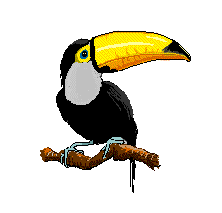|
|
|


A WebQuest for 3rd Grade Designed by Maureen Mooney Introduction | Task | Process | Evaluation | Conclusion | Credits | Teacher Page Welcome to the Rainforest. You are now being hired as a Rainforest Animal Expert. There are many people who want to get rid of the beautiful rainforest to make money from the land. Over half of all plant and animal species live in the rainforest. Save the Rainforest Project needs your help to tell these companies about so many of these wonderful creatures and why the rainforest is important to these animals. Your job over the next month will be to research and develop a written report, visual project, and be prepared for an oral presentation about an animal that lives in the rainforest. You will need to explain why your animal needs the rainforest to survive. After choosing the animal in class with your teacher, you will need to follow the steps provided to make your journey a success. You will use non-fiction books, CD-ROMS, and the internet to gain valuable information about your animal. The class will be starting in the library to research and take notes. There are many books available in our school library as well as in your classroom that you will be able to borrow. You will also use the internet for current facts and pictures of your animal for your written report. Good Luck!
Now that you have choosen your Rainforest Animal, you are required to address several questions in your written report. The written report should include pictures or your own illustrations of your animal.
You should write in complete sentences.
The final report should be put together in an attractive way (mounting the pages, using a folder, etc.) If you include your information on your visual piece, you will still need to hand in another copy to your teacher.
You are required to hand in on May 1, 2001 a written report that covers these questions:
Each of you will need to have one or more visuals to show the class during your presentation. This is where you can really get creative! You may try one or more of the following ideas or clear a new project with your teacher: After you have researched and written your report, you will be ready to tell your classmates about your animal.
Rather than reading directly from your report, each of you will tell what you have learned and show your visual project.
Make sure that you practice telling a family member or two what you learned about the wonderful animal you have spent time researching.
2. Once you have the name of your animal, you will begin to look for information in different sources. You will need to keep track of where you found your information by writing the author, title, and copyright date for each source of information.
3. You will need to find information from at least one book source, a CD-ROM, and a website. We will work in the Library Media Center for five class periods and will have class time too.
4. You will take notes on all the questions listed above in your Social Studies Notebook and any other information on your animal that you think is interesting.
5. Once you have finished gathering information, you will need to write a sloppy copy of your report that will be handed in to your teacher to edit.
6. Your teacher will go over the edited copy with you, then you will work on the final draft. This may be done at home or in the computer center.
7. At home you will work on the visual project of your choice that shows some detail about how your animal lives.
8. Practice your oral presentation with your family. You may use index cards to help you.
9. Bring in both written report and visual project on May 1st.
10. Each of you will be doing your oral presentations one day that week.
Research
Animals of the Rainforest --A wonderful place to find your animal by species
(mammal, reptile, amphibian). This site has more links to research to find out more information.
Zoom School...Rainforest --Shows you some information on several rainforest animals. Includes pages to print off of rainforest animals.
Very Cool Bugs -- Describes many kinds of insects, spiders, and butterflies.
Kids'
Action: Rainforest Animals-- A page with a few animals and reasons for protecting the rainforest.
ZOOM SCHOOL-- Lists a large number of animals and how they grow.
Rainforest Live KidZone--Many animals are mentioned with some facts. You can search their page for pictures and facts.
Rainforest Explorer--Good selection of animals with facts.
Seaworld..Animal Bytes -- Lots of good animal links!
You will be given an individual report card based on the rubric below that will tell how well you completed your task. Not Yet 1 Developing 2 Accomplished 3 Exemplary 4 Score Once the month long project is completed, the students will have learned not only about their own Rainforest animal and also about many more animals that live in the rainforest. They will hopefully have a better appreciation for why Rainforests need to be saved and not destroyed since so many creatures rely on this tropical ecosystem.
KIDS! Have a little more fun on these sites and find out what you can do to help protect the rainforest.
If you would like to read more about Rainforests, please check out these books:
|






